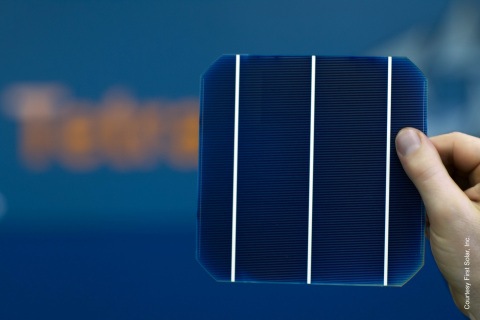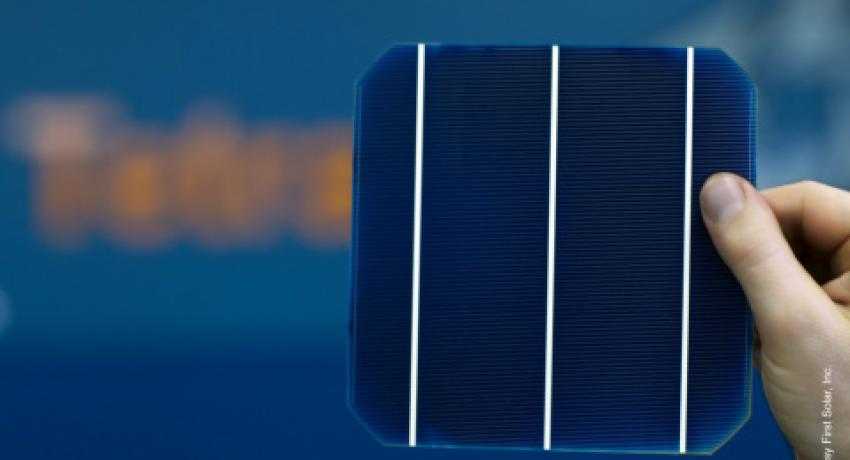First Solar sets sunny outlook for 2013
 During First Solar’s first analyst meeting in four years Tuesday (April 9), the company announced an ambitious outlook for 2013, including higher earnings expectations for the year, the purchase of a PV manufacturer that uses silicon PV and world record-breaking efficiency levels for its cadmium telluride (CdTe) modules. The trifecta of good news sent the company’s stock up sharply yesterday (45 percent) and may be among the growing signs that the solar manufacturing industry is starting to recover from a couple of bruising years of competition. However, as Raymond James Equity Analyst Pavel Molchanov and others pointed out—now its time for the hard work to begin.
During First Solar’s first analyst meeting in four years Tuesday (April 9), the company announced an ambitious outlook for 2013, including higher earnings expectations for the year, the purchase of a PV manufacturer that uses silicon PV and world record-breaking efficiency levels for its cadmium telluride (CdTe) modules. The trifecta of good news sent the company’s stock up sharply yesterday (45 percent) and may be among the growing signs that the solar manufacturing industry is starting to recover from a couple of bruising years of competition. However, as Raymond James Equity Analyst Pavel Molchanov and others pointed out—now its time for the hard work to begin.
Maybe it’s enough in a day for a solar company to announce that it just broke a world record for its type of PV module, which in First Solar’s case is CdTe. Yesterday it started the day off by announcing that the National Renewable Energy Laboratory (NREL) confirmed that its new module reached 16.1 percent conversion efficiency. The company previously set the record at 14.4 percent efficiency in January 2012.
Then the company announced its guidance for 2013. During the analyst day meeting, the company said it anticipates shipping between 1.6 gigawatts and 1.8 gigawatts of modules, netting sales between $3.8 billion and $4.0 billion. And it anticipates full-year earnings per share between $4.00 and $4.50.
The company closed the event with another surprise, the purchase of TetraSun, a startup silicon PV company, making high-efficiency PV cells that can achieve more than 21 percent conversion efficiencies. The company uses a proprietary cell architecture that minimizes process steps and some of the expensive components used in other silicon cells, according to First Solar. "This breakthrough technology will unlock the half of the PV market which favors high-efficiency solutions, which has been unserved by First Solar to date," said Jim Hughes, CEO of First Solar. TetraSun could open two markets to First Solar, small commercial and residential, both of which could be drivers for the industry as interest in utility-scale projects wanes. The company could start the commercial manufacture of TetraSun’s technology as soon as 2014.
In the past some industry insiders have said that First Solar should consider focussing on building solar farms, maybe even more so than producing its own PV modules. The purchase of TetraSun could be a sign that the company now is looking at other directions. Regarding the purchase of TetraSun, Molchanov said: “It is intriguing to see First Solar venture in an entirely new direction. Stay tuned on this one.”
This trio of positive news sent the company’s stock up significantly—it’s fallen about 5 percent today (April 10) from the 45 percent jump it saw yesterday. Given the recent story of the solar industry the news wasn’t enough to assuage all analysts’ concerns. For instance, Molchanov wrote in a research note, “The sudden tidal wave of bullishness is not going to sweep us off our feet.”
Molchanov observed that First Solar’s balance sheet has remained healthy and company profitable because of it legacy utility-scale projects in the U.S. “As those gradually roll off, however, we envision challenges in maintaining (to say nothing of growing) profitability. While the efficiency and cost targets are ambitious, they do not change the reality that CdTe technology's economic advantage compared to crystalline technology appears to be gone for good,” he said.
Along with all the other news, First Solar also boosted its CdTe efficiency roadmap. It now anticipates that its thin-film PV modules will reach between 15 percent and 16.2 percent efficiency by 2015 and by 2017 will be between 16.4 percent and 17.1 percent efficient.




